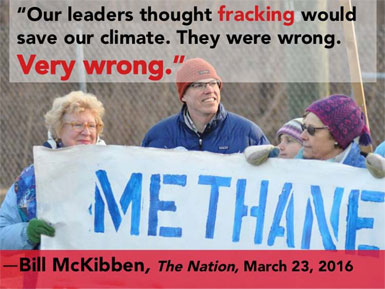"If we continue methane production at current rates, the world will run up against the 1.5° limit in 12-15 years. If we stop producing methane, which means stopping fracking of natural gas and oil, the world wouldn’t run up against that limit for about 50 years," Robert Haworth, a Cornell professor who has done cutting edge research on fracking, told The Nation.
Emissions from fracking are "big enough to wipe out a large share of the gains from the Obama administration’s work on climate change – all those closed coal mines and fuel-efficient cars. In fact, it’s even possible that America’s contribution to global warming increased during the Obama years," writes Bill McKibben of 350.org in The Nation.
In the US, methane emissions are up over 30% since 2002, accounting for 30-60% of the enormous spike in atmospheric methane, according to a Harvard University study. While researchers don’t attribute a source for the rise, it occurred since fracking began in earnest in the US.
"Methane emissions make it a disastrous idea to consider shale gas as a bridge fuel, letting society continue to use fossil fuels over the next few decades," says Robert Haworth, Professor of Ecology and Environmental Biology at Cornell University, whose research first exposed the spike in methane.
Read our article, US Methane Emissions Beat Estimates, Thanks to Fracking.
The industry is digging its own grave by allowing these emissions, because it originally had widespread support as an alternative to coal. President Obama saw it as a bright spot in a dead economy when he entered office – offering lots of jobs and home grown, cheap energy that even brought overseas manufacturers back home.
But as frackers moved from rural areas where few people live to places like the Marcellus Shale in Pennsylvania, contamination of farms and drinking water became obvious … and the movement against it began.

Meme created by Carmi Orenstein
Opposition Builds
For the first time, a majority of Americans oppose fracking, according to Gallup’s 2016 environment poll. Opposition rose 11% over the past year to 51%.
The change comes mostly from declining support by Republicans, down 10% last year to 55%. 34% of Independents support fracking and 25% of Democrats.
Fracking’s footprint has grown exponentially in the past few years, impacting millions of people directly, whether through polluted drinking water, earthquakes, train bombs carrying oil through communities, or the vast methane plume in California.
In 2000, about 23,000 fracking wells produced 102,000 barrels of oil a day in the US, but by 2015, it grew to 300,000 wells pumping over 4.3 million barrels a day.
California’s four-month Aliso Canyon gas leak brought widespread attention to methane emissions, but when you combine all the leaks in Texas’ Barnett shale region, they are even bigger.
Finally, efforts are underway to rein in emissions by the EPA, Interior and Energy Departments. The goal is to cut emissions from oil and gas 40-45% by 2025 (below 2012 levels).
Hillary Clinton’s Role
As Secretary of State, Hillary Clinton worked with energy companies to spread fracking around the world. She saw it as a way to address climate change, help countries boost their energy supplies, while undercutting adversaries such as Russia, according to Mother Jones.
Clinton named a special envoy for international energy affairs to "to elevate energy diplomacy as a key function of US foreign policy."
In a cable to US diplomats, she asked them to collect information on the potential for fracking in their host countries. These efforts underpinned a new "Global Shale Gas Initiative," to help countries develop their shale potential, "in a way that is as environmentally respectful as possible."
She created the 63-employee Bureau of Energy Resources to promote fracking, twisting the arms of world leaders to allow US firms to frack at will, according to WikiLeaks.
Bulgaria, for example, signed a $68 million deal with Chevron in 2011 for millions of acres of shale leases. When the public revolted in protest, she sided with Chevron, offering to fly in specialists that could present fracking’s benefits to the people. Meanwhile, her energy envoy lobbied against a fracking ban in neighboring Romania. Fracking bans have since been dropped, and today, the State Department provides "assistance" with fracking to dozens of countries, from Cambodia to Papua New Guinea, reports Mother Jones.
It extends to indigenous tribes in Brazil’s Amazon where a judge finally ordered all oil and gas activities cancelled in Acre, thanks to the work of Não Fracking Brasil. The fight goes on in Brazil.
 Acre is home to the highest concentration of uncontacted indigenous peoples in the world. credit: 350.org
Acre is home to the highest concentration of uncontacted indigenous peoples in the world. credit: 350.org
"If the State Department has its way, in a few years Harvard’s satellites will be measuring gushers of methane from every direction," says Bill McKibben.
In a recent position paper, Clinton says "Natural gas has helped US carbon emissions reach their lowest level in 20 years." Now, in debates with Bernie Sanders – whose position is to ban fracking – she says she would strongly regulate it as President.
To her credit, Clinton also formed an international coalition to address short-term climate forcers, which includes methane.
Meanwhile, the first US shipment overseas took place last month, from an export terminal in Louisiana.
Also, under Clinton’s leadership, the US promoted GMO agriculture across the world, and approved the Keystone Pipeline.
